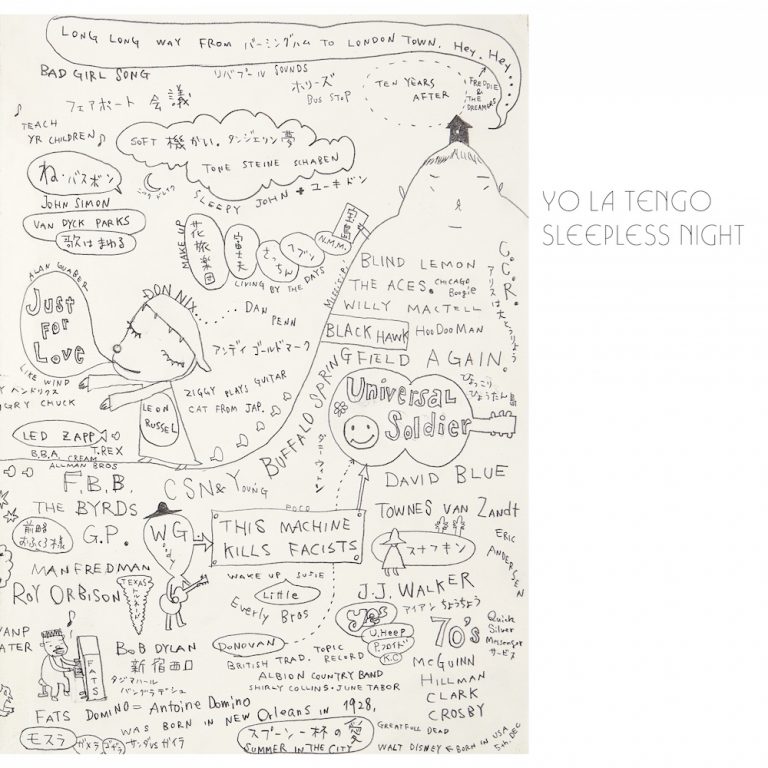In many ways, Yo La Tengo are the quintessential cover band. Not in the sad and tired group-singing-too-many-beach-boys-songs-at-a-wedding sense, but as prolific musicians who know exactly how to consider other artist’s music and incorporate it into their own inimitable style. How many Yo La Tengo songs have been mistaken for originals? Probably a few. Depending, for instance, on one’s familiarity with George McCrae, their version of “You Can Have It All” is the definitive version of that song. Their latest EP, Sleepless Night, is yet another testament to the band’s knack for regurgitating unsung songs of old and highlighting them to a new audience; they are curators of a musical museum, deciding what they think their listeners would like to discover.
For this outing, the Hoboken three-piece – Ira Kaplan, Georgia Hubley, and James McNew – have brought together several lesser-known classics from the 40s, 60s, and 70s. The group always takes care not to cover songs that are too well-known, which would thus be too difficult to spin in their own way. Sleepless Night followed the band’s other 2020 release, the completely instrumental We Have Amnesia Sometimes, a record that didn’t always land. That’s rectified for this EP, where they’ve covered five old American songs, alongside one original (“Bleeding”).
Yo La Tengo has also always been defined by the subtle changes in the time of day. This was never clearer than on their classic LP, And Then Nothing Turned Itself Inside-Out, a record that so belongs to that tiny moment when dusk melts into nighttime, when America powers down, awaiting another day of searching for that elusive Dream.
What time does Sleepless Night belong to? It’s not dusk, nor does it feel like it belongs to true nocturnality. Rather, the EP flutters somewhere in the gaps. Sleepless Night: perhaps that title alludes to the need for nostalgia right now, when the U.S. appears constantly in a state of terrifying insomnia. Lucky that Yo La Tengo is around then. From the start, “Blues Stay Away from Me” incorporates a loving three-part harmony that gathers the track in its lilting grasp. This is as languorous as the band ever gets, as minimal as they want to be. Their cover retains enough of the old-time quality of the Delmore Brothers’ 1949 original, layering their updated harmonies in a dreamier and more soothing way.
“Wasn’t Born to Follow”, a Byrds song (also memorably featuring in the 1969 counterculture classic Easy Rider), is their most faithful adaptation, retaining the buoyant jangle of the original; it’s almost possible to trace a line between The Byrds and Yo La Tengo’s lightest indie stylings. “Roll On Babe” sees them remembering the oft-forgotten folk singer Derroll Adams, though their cover more closely follows Ronnie Lane’s 1974 version of the same song. It’s a tender acoustic piece, perhaps not enough being changed in their hands to be noteworthy. “Smile a Little Smile for Me” was a 1969 song by the British band The Flying Machine, and in Yo La Tengo’s hands it’s a simplistic closer, stripped-down to just Kaplan’s lament rising above a wistful acoustic guitar, again not their most miraculous reworking.
“It Takes a Lot to Laugh, It Takes a Train to Cry” doesn’t suffer from this problem: the band arranges it unrecognisably from Bob Dylan’s first version, imbuing it with a dreamlike haziness as they do best. There is an incessant humming sound (it’s unsurprising to discover that this was recorded during the sessions for that gorgeous record, And Then Nothing Turned Itself Inside-Out), and the atmosphere is thick with momentous melancholy. It is, simply, a wondrous example of what a cover should be.
There is, of course, also an original work. The aforementioned “Bleeding” is pure Yo La Tengo, drifting within the margins of genres: it thrums with a delicate ambience, it’s coloured by a plaintive psychedelic touch, its melancholic indie-rock also impresses upon the listener. It’s fuzzy and ethereal and moving and makes one glad that they don’t just record covers after all.
Nothing on Sleepless Night necessarily surprises, but nothing disappoints either. For a band with 15 studio albums (and counting), we unsurprisingly don’t discover anything new about them here, but this isn’t the point. We’re just glad to be in their company once again; this, one feels, will never change.

